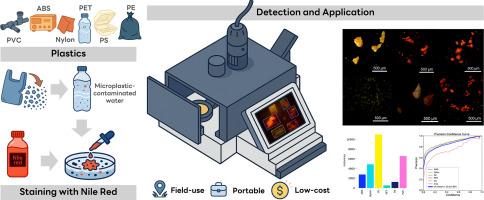Low-cost portable microplastic detection system integrating nile red fluorescence staining with YOLOv8-based deep learning
IF 7.7
Q2 ENGINEERING, ENVIRONMENTAL
引用次数: 0
Abstract
Microplastic (MP) pollution presents considerable challenges to aquatic ecosystems and human health, yet cost-effective detection methods remain limited. This study presents a portable, low-cost MP detection device combining Nile Red (NR) staining with YOLOv8-based deep learning (DL). The compact system (22 × 23 × 20 cm) uses a digital microscope, optical filter, 395 nm UV source, and Raspberry Pi 4 (RPi4) as the central processing unit. This design provide a portable and affordable alternative to expensive laboratory-based detection methods. In testing six common polymers (ABS, Nylon, PE, PET, PS, PVC), the system achieves 94.8 % mean average precision at IoU threshold of 0.5 (mAP@50), with excellent performance for PE and Nylon (96.5 %). Each polymer exhibits distinct fluorescence patterns enabling robust automated classification. Economic analysis demonstrates 77.3 % cost reduction compared to conventional FTIR methods, from $0.44 to $0.10 per sample, with fixed costs of only $139. The 19-second processing time enables high-throughput analysis suitable for field applications, citizen science, and resource-limited settings. Detection is limited to particles >100 μm by microscope resolution. This technology enhances MP analysis accessibility, bridging the gap between expensive laboratory methods and practical environmental monitoring for widespread community use.

尼罗红荧光染色与yolov8深度学习相结合的低成本便携式微塑料检测系统
微塑料污染对水生生态系统和人类健康构成了相当大的挑战,但具有成本效益的检测方法仍然有限。本研究提出了一种将尼罗红(NR)染色与基于yolov8的深度学习(DL)相结合的便携式、低成本MP检测设备。紧凑的系统(22 × 23 × 20厘米)使用数码显微镜、光学滤光片、395nm紫外源和树莓派4 (RPi4)作为中央处理单元。该设计为昂贵的实验室检测方法提供了一种便携且经济实惠的替代方案。在测试六种常见聚合物(ABS, Nylon, PE, PET, PS, PVC)时,该系统在IoU阈值为0.5时平均精度达到94.8% (mAP@50),其中PE和Nylon性能优异(96.5%)。每种聚合物都显示出不同的荧光模式,从而实现强大的自动分类。经济分析表明,与传统的FTIR方法相比,成本降低了77.3%,每个样品的成本从0.44美元降至0.10美元,固定成本仅为139美元。19秒的处理时间使高通量分析适用于现场应用,公民科学和资源有限的设置。通过显微镜分辨率检测仅限于颗粒>;100 μm。这项技术提高了MP分析的可及性,弥合了昂贵的实验室方法和广泛社区使用的实际环境监测之间的差距。
本文章由计算机程序翻译,如有差异,请以英文原文为准。
求助全文
约1分钟内获得全文
求助全文
来源期刊

Journal of hazardous materials advances
Environmental Engineering
CiteScore
4.80
自引率
0.00%
发文量
0
审稿时长
50 days
 求助内容:
求助内容: 应助结果提醒方式:
应助结果提醒方式:


